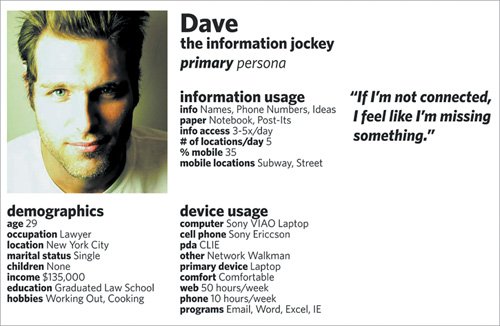Personas
| Personas (Figure 5.8) are a documented set of archetypal people who are involved with a product or service. They're supposed to give designers a sense that they are designing for specific people, not just "the users," who, if ill-defined, can be twisted to serve any purpose. ("Of course the users will want to enter a password on every page!") Figure 5.8. A sample persona. Personas turn "the users" into identifiable human beings. Designers should devise personas from observing and talking to users. Personas are typically amalgams of multiple people who share similar goals, motivations, and behaviors. The differences between each persona must be based on these deep characteristics: what people do (actions or projected actions) and why people do them (goals and motivations). What personas shouldn't be are users who have similar demographics. Focusing on demographics will provide market segments, not personas. The only time demographics really matter for personas is when those demographics directly affect user behavior. A 13-year-old will probably use a product differently than an 83-year-old. A rural peat farmer in Ireland might use a product differently than a Korean financial analyst in Seoul. But maybe notdemographics may not matter at all. In fact, using demographics could limit and hinder the usefulness of the personas. For products with millions of users, for example, a designer could end up with hundreds of personas, and such a large set is essentially useless. To create a persona, designers find a common set of behaviors or motivations among the people they have researched. This set becomes the basis for the persona, which should be given a name, a picture, and a veneer of demographic data to make the persona seem like a real person. For example, consider a design project related to airline travel. Designers have observed three sets of behavior: flying frequently for business, flying occasionally for pleasure, and flying habitually every fall and spring (the snow bird phenomenon). Each of these behaviors is tied to specific other behaviors while traveling, with different goals and motivations. The behaviors become the basis for three personas: Bob, the frequent flier; Susan, the vacationer; and Wilma, the snow bird. Quotes pulled from the research are helpful for distinguishing and identifying personas ("I fly at least once a week"), as are simple titles ("The Frequent Flier"). The persona documents should clearly note the behaviors, motivations, and goals that differentiate one persona from another. Bob cares deeply about getting to his meeting or hotel on time, while Wilma is more relaxed about what happens after the flight. For most projects, the number of personas should be smallanywhere from 1 to 7. After about 7 personas, remembering and distinguishing them becomes difficult (recall the Magical Number Seven rule from Chapter 3). Most important, it becomes difficult to design for such a large group. Imagine creating a mobile phone that will satisfy a dozen very different people. The debate that would go on among those people would make it difficult for the designer to accomplish anything. Unless you are designing for millions of users, you should consolidate personas to fewer than 7. While both designer and client will usually want the product or service to work for the largest possible group, 7 personas should be enough to cover 95 percent of the users. A product or service that is being designed to accommodate more personas likely isn't focused enough on the core behaviors that need to be addressed. Once you have a set of personas, find a face for each. Pictures, more than anything else, will humanize personas and make them memorable. As long as the personas won't be made public, an online dating service like Yahoo Personals is an excellent place to find persona pictures. Personals contain (mostly) flattering pictures that can be browsed according to any combination of gender, location, age, ethnicity, and other factors. Personas by themselves are fairly useless. They become useful only when the designer sets up scenarios and uses the personas to test features for appropriateness and utility. Designers can then ask themselves: Would this persona do this task? Could this persona do this task as it is designed?
Designers (and, indeed, businesses) can also use personas to set priorities. The persona that represents a majority of a product's users may not be the user that the organization values the most; other personas may make the organization more money, be more involved, use more features, and so on. Organizations can and should use personas to make strategic decisions. While many find personas helpful, some designers don't care for them. For these designers, personas form an artificial barrier between the product and its users. Some projects, especially smaller ones, may not warrant a full set of personas. But for many designers, if their personas are based on research and focused on the right characteristics (behaviors, motivations, and goals), personas are a valuable tool. |
EAN: 2147483647
Pages: 110
